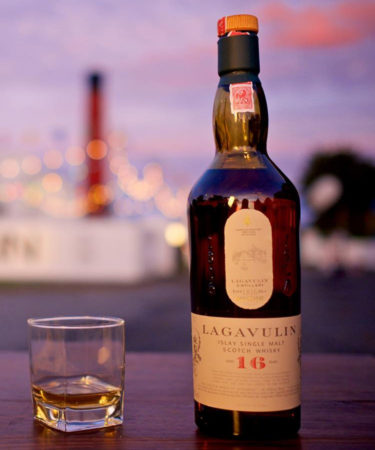An iconic Scotch whisky, Lagavulin is synonymous with Islay’s signature peat. Its range spans golden pours aged in new American oak, amber single malts ideal for those presently or aspirationally wearing Shetland sweaters, and a rich, russet, sherry-aged distiller’s edition. Its celebrity fan base and pop cultural allure abet more than 200 years of history and awards.
Curious to learn more about the iconic Islay whisky? Fill your glass with these eight facts.
There are five bottles in Lagavulin’s fleet.
Its most famous is Lagavulin 16, a full-bodied single malt that clocks in at 43 percent ABV. It’s aged in oak for a minimum of 16 years (hence the name) and has massively peaty, smoky flavors, plus lingering sweetness, wood notes, and smoke on the finish. “The Lagavulin 16-year-old is a fundamental part of Islay’s whisky heritage,” writes Harry Cockburne in The Independent in December 2017. The label also makes Lagavulin Distillers Edition, which is double-matured in Pedro Ximinez casks, as well as Lagavulin 1991, and 8- and 25-year-old whiskies.
It’s big in San Francisco.
At the 2017 San Francisco World Spirits Competition, a spirits forum founded in 2000, Lagavulin’s 16-year Scotch was named the Best Distiller’s Single Malt of 2017 and won a double gold medal, meaning it received unanimous gold-medal scores from all panelists. The 16-year also got four consecutive double gold medals between 2005 and 2008.
Speaking of superlatives…
The Glenesk Hotel in Angus, Scotland broke a world record for the largest whisky collection in December 2017. Its 2,500 bottles comprise 1,031 on the official hotel docket as well the owners’ 1,449-bottle private collection. (Sidebar: We need to meet and befriend these owners ASAP.) The most expensive pour on the list is Lagavulin 25, which retails for £248 per dram (approximately $345).
It was officially founded in 1816, but distilling started much earlier.
According to Lagavulin lore, people were making whisky on site as early as the 18th century. In 1816, one remarkably named local, John Johnston, launched the first legal distillery. In 1819, Archibald Campbell launched a rival operation. They eventually united forces and, in 1887, were collectively owned by whisky scion, Scottish Unionist, and general firebrand Peter Mackie.
Lagavulin pairs well with stylized American masculinity.
Nick Offerman, the mustachioed actor who famously played Ron Swanson on NBC’s “Parks and Recreation,” is an enormous Lagavulin fan. He creates limited-edition Lagavulin tableware in his L.A. wood shop, and called Lagavulin “mother’s milk” in a 2013 interview with Bloomberg BusinessWeek. He also celebrated New Year’s Eve 2016 with a dram of Lagavulin at the Islay distillery. Fictitious character Ron Swanson also loves Lagavulin 16; in the sixth season, Swanson visits the distillery, and in the series finale becomes a Lagavulin shareholder.
Music makes its heart sing.
Lagavulin releases a limited-edition whisky every year in conjunction with the Islay Jazz Festival. Last September, there were 6,000 Jazz Festival bottles available; all were matured in refill American oak hogheads and first-fill American oak. A sponsor of the festival since 2010, Lagavulin has produced a tie-in bottle every year since 2011.
Like all 8-year-olds, Lagavulin’s simply will not stop.
Launched in 2016 to commemorate Lagavulin’s 200th anniversary, and intended for limited release, the 8-year whisky is now a permanent fixture. It was created to honor Great Britain’s “most famous and first-ever whisky writer, Alfred Barnard,” Georgie Crawford, distillery manager, said in a 2017 interview. “In the late 1880s, Barnard sampled an 8-year-old Lagavulin during a visit to Islay, describing it as ‘exceptionally fine’ and ‘held in high repute,’” she says.
A literary icon described Lagavulin as something that could “be used to tar a boat.”
Lisbeth Salander, heroine of Stieg Larsson’s “The Girl Who Kicked the Hornets’ Nest,” sips Lagavulin when she finds herself bellying up to the bar at The Rock Hotel on Gibraltar. After tasting it she pushes it off, saying it resembles pitch. Hey, everyone’s a critic.
